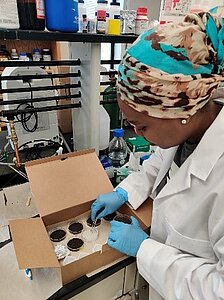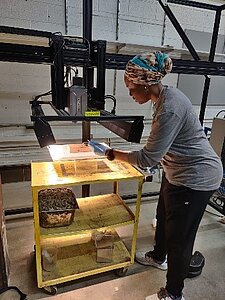Fate and Transport of Microplastics in the Natural Environment

Mansurat Abdulmalik Ali is a Ph.D. graduate student in the department of Environmental Engineering working with an Advisor Dr. Feng (Frank) Xiao of Civil Engineering department, School of Engineering and Mines at University of North Dakota (UND). She holds a master's degree in Earth Systems Science and Policy from UND (2017-2019) and an undergraduate degree in Chemistry from Kogi State University (2006-2010). She has previous experience working in the manufacturing industry and a freelance cisco network professional prior to joining UND. Her current research is focused on using hyperspectral imaging system to identify microplastics in controlled and natural environment. The goal of this work is to develop a nondestructive, efficient, and reliable methodology of microplastic characterization while identifying its transport mechanisms in the environment.
Fate and transport of microplastics in the natural environment
Microplastics (MP) generated by run-offs, littering of plastics and those from agricultural practices through application of contaminated soil amendments and irrigation systems are all absorbed into the soil. The topsoil act to harbor fragmented plastics upon exposure to the environment making it vulnerable to contamination. Microplastics are known to be persistent as they don’t biodegrade, they accumulate acting as host to persistent organic pollutants which can be easily transported from one location to another while leaching out chemical additives that get absorbed into the soil matrixes and making them inhabitable over a long period of time. The persistent of MPs in the environment has intensify the need for an efficient and reliable techniques for MP identification in soil and water as traditional method such as Fourier transform infrared spectroscopy (FT-IR) and Ramen spectroscopy requires large representative samples from the field of study, intense sample preparation with one-point analysis which is time-consuming and labor intensive. These limitations stand to inform the objectives of this research to explore new method such as hyperspectral imaging (HSI) technology to effectively identify and characterize MPs in soil and water.
HSI system is an effective, fast, and nondestructive technology which integrates optics and digital information processing while outputting spectral signatures and spatial information of samples measured. The technology can be employed to generate the different absorbance and reflectance of samples by using their various chemical compositions and functional groups at distinct wavelength. This functionality would enable this research to carry out qualitative and quantitative analysis on spectral images to determine MPs composition and other properties
Research Objectives:
- To utilize HSI in classifying various MP polymers in soil and water
- To determine the effect of different sample matrixes on MP characterization.
Progress:
Preliminary Microplastics Identification
Two laboratory grade soil (sand and clay) and three plastics resins (PE, PP, PS) were purchased, measured, and prepared for hyperspectral imaging. The soil and plastic samples were passed through stacked metal sieves (less than 5 mm) to meet the MP requirement, the MP resins were then added to the soil samples at different categories namely: soil, soil + PE, soil + PP, soil + PS. Six different MP concentrations of 1%, 2.5%, 5%, 10%, 15%, and 20% were used for each plastic type per 10g of each soil type and sample. The same method was applied to water and MP. Pure deionized water (DI water) was used, and the categories include DI water, DI water + PE, DI water + PP, DI water + PS at the same above concentration per 10 ml of DI water sample. Six parallel experiments for each category were conducted with a total of 84 samples.
Spectral Data Acquisition
The soil samples were scanned by a hyperspectral imager. The spectral wavelength range of the imager using the shortwave infrared sensor (SWIR) is 1000 – 1700 nm, the exposure time of the camera was set at 5 ms and 10 ms. The platform moving speed was at 1 cm/s, and the spectral resolution at 6 nm.
Spectral Pretreatment (Current Phase)
The collected spectrum containing the chemical information of samples is currently being analyzed.
Conferences/Seminar Presentations
Mansurat Abdulmalik Ali and Feng (Frank) Xiao. Graduate Research Achievement Day, University of North Dakota (2022) - Poster presentation: Fate and Transport of Microplastics in the Natural Environment
Mansurat Abdulmalik Ali and Feng (Frank) Xiao. Established Program to Stimulate Competitive Research (EPSCOR), North Dakota State Conference (2022) - Virtual poster presentation: Review of Fate and Transport of Microplastics in the Natural Environment
Mansurat Abdulmalik Ali. Department of Civil Engineering (UND) Seminar Presentation (2021): Microplastics in Soil.



Feng "Frank" Xiao
Civil Engineering
Office: Upson II Room 260K
243 Centennial Drive Stop 8115
Grand Forks, ND 58202-8115
Telephone: 701-777-5150
Email: feng.xiao@UND.edu


